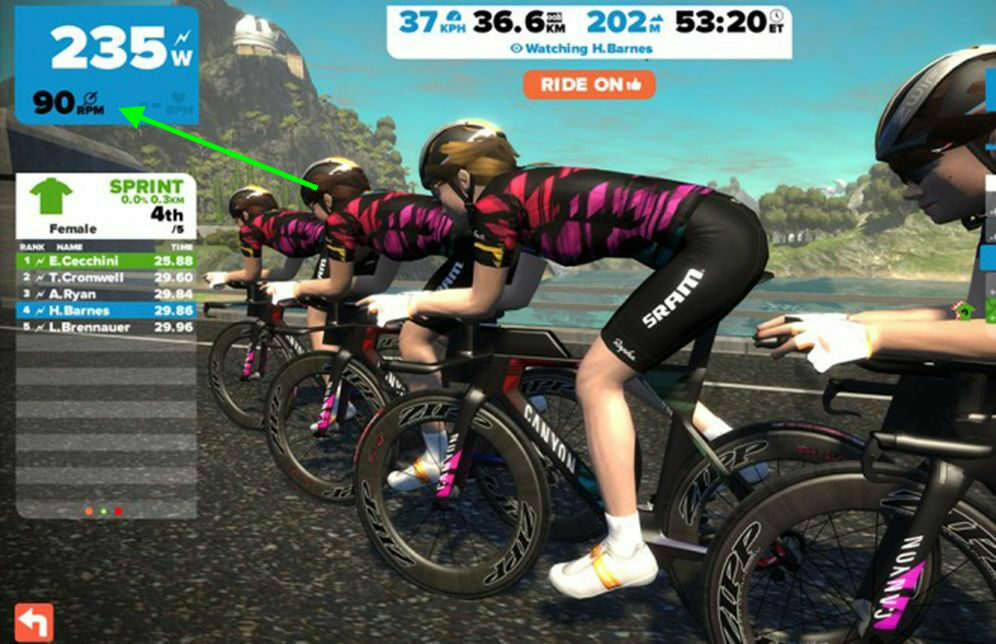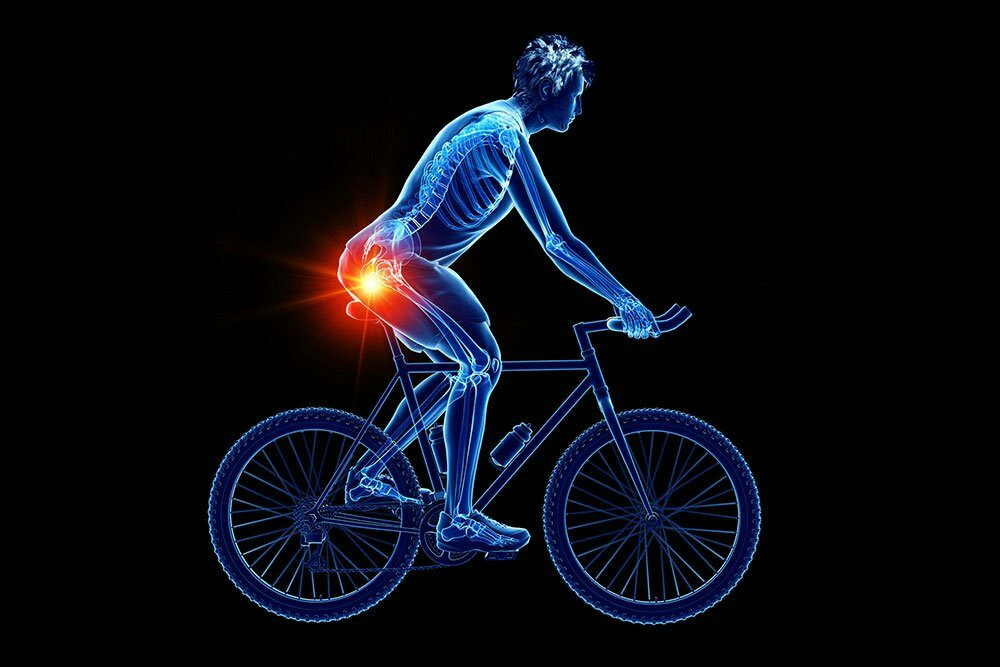Ever wonder what cadence you should ride at when tackling climbs? Well, it really depends on the person. As for me, I’ve realized it’s high time I start climbing with a quicker spin.
Why, you ask? Simple—I want to be pedaling strong for many years ahead!
What is Cadence?
Cadence is basically how many times your pedals go round in a minute as you ride. It’s really that simple.
Curious about your cadence while cycling on Zwift? It’s easy! Just glance at that graphic up in the top left corner.

Sure, Zwift gives you that RPM number, but you can totally do it on your own. Just start a stopwatch, and every time your pedal hits the top, give it a count. Do this for a minute, and boom—you’ve got your cadence!
Cadence can affect many aspects of your ride, but let’s zero in on how it influences your body — specifically on climbs.
When it comes to muscle endurance, cadence plays a big role. If you keep a higher cadence, you’re giving your cardiovascular system a workout. On the flip side, a lower cadence means you’re putting more of the load on your muscles.
…and that’s where my problems began.
Mashing the Pedals
First up, let’s talk about why stomping on those pedals can be a bad idea.
Pedaling like a jackhammer might feel powerful, but real cycling magic happens when your legs work in smooth, graceful circles—not stomping like you’re crushing grapes for wine!
Mashing the pedals burns your energy and leaves you running on empty long before the finish line.
And let’s be real, it can seriously mess up your body too.
Knee Strain: Crushing those pedals can put a lot of stress on your knees, particularly on the quadriceps tendon, which might cause ongoing knee pain or even lead to injuries.
Not really an issue for me. Go on…
Lower Back Pain: Usually kicks in when your upper body’s not stable, or if your posture is off while you’re tackling those climbs.
Hmmmm…we might be on to something here. Go on…
Back and Hip Issues: When you mash those pedals, your hips and lower back have to work overtime since your movement isn’t as smooth, which can unfortunately lead to overuse injuries in these areas.
Nailed it. We’re talking back aches, hip troubles, and yep, painfully sore glutes!
How I Turned into a Pedal Stomper
I’m the DS, captain, and a fellow rider on Team OWL—our Grandmasters race team—and I absolutely love it! But hey, I’m not exactly the powerhouse of the group.
At 167 cm and a mere 50.4 kg, this 65-year-old “featherweight” has a hard time cranking out massive watts. Just so you know, “massive” is kinda relative when you’re talking about a Grandmasters team!
Just so you know, “massive watts” is kinda relative when you’re talking about a Grandmasters team!
On a good day, my 3 w/kg gets me to about 150 watts. The top three cyclists on our team are cranking out zFTPs of 193w, 186w, and 174w. Not too shabby for a 72-year-old, a 67-year-old, and a 60-year-old – respectively. Hoot!
During our weekly TTT races, we push 185w at the front on our pulls. For the top two riders, that’s chill because it’s below their zFTP. For our third rider, it’s just 6% above her FTP. But for me? It’s a whopping 34% above mine!
Faced with this challenge, I put my thinking cap on and devised a way to stick with the team. My solution? Mixing it up by spinning at 80-85 rpm in-the-saddle and throwing in out-of-the-saddle bursts of sub-70-rpm pedal mashing. Honestly, every race felt more like interval training for me!
And it worked.
Until it Didn’t…
Team OWL’s been tearing up the women’s Grandmasters race scene together for over 5 years. My game plan was crushing it for a while, but a few years back, it hit a snag. Got a solid three years out of it, though!
I began feeling some discomfort in my lower back, hips, and glutes, and over time, it just kept getting worse. It was quite literally a pain in the butt!

But Wait. There’s a Cure for this, Right?
I’ve never really had to deal with chronic pain before, so I was pretty confident the docs could sort it out. And so, my adventure began.
To spare you from what I like to call ‘organ recitals,’ which are all too common in my age group, here’s the quick and dirty (and often humorous) Cliff notes:
- First doc visit: basically told me I’m just getting old, aches are par for the course, and I should give PT a shot.
- Physical Therapy: got some funky exercises, but no dice.
- MRI scan: bones look great, but you’ve got a high-grade ligamentum teres tear and a partial labral tear. Advice? Nothing until it was time for a hip replacement. I had to remind the doc that my bones are in tip-top shape, and I’m not planning on needing one ever—and got hit with a blank stare.
- Round two of PT: worked on stability and tried some needling with e-stim. A bit of relief!
Hey, remember when I mentioned that being a pedal masher can really mess things up with your body? Yeah, a labral tear is one of those nasty outcomes!
A Labral tear can happen when you put too much stress on the hip joint—usually by pushing yourself too hard. Checkmark.
Oh, and just to throw it out there, even though I experienced a bit of pain cycling, walking was the real troublemaker. My right glute was not happy, and the pain shot right down my leg, making it go numb after just a few blocks.
With my trip to Long Beach coming up, I was pretty sure I’d nail the TTT at Zwift HQ, but I was seriously stressing about missing out on the fun touristy stuff with my teammates simply walking around town.
Time to take action.
A doc had suggested an epidural steroid injection months ago, but I’m all about trying every possible fix before going for what feels like the ‘big guns.’ Yeah, yeah, I get it—an ESI isn’t exactly dealing with dynamite. But hey, it’s who I am!
And it Worked!
Our TTT race was a total blast! Hanging out and exploring Long Beach with my teammates was awesome—and, best of all, I was totally pain-free!
After returning home, the magical effects of that injection lasted a good few months. Then, the annoying ache in my right glute decided to make a comeback. It feels like having a wad of muscles all tangled up inside.
So, the same doc has been doing trigger point needling. It chills out those cranky muscle fibers, gets the blood flowing, kicks those pesky pain chemicals to the curb, and basically helps my muscles get back to feeling normal again.
The fix doesn’t last forever, but I can grab a treatment whenever it’s needed. Plus, since there’s no meds involved, there are zero side effects.
I can live with that.

Then I snapped…
Or at least that’s how it felt!
Two weeks ago we raced WTRL’s TTT on Greatest London Loop. Yeah, the one with the brutal Keith Hill Climb: 1.9 km long, averaging a 7% incline, with some parts spiking over 10%.
Halfway up the climb, something in my hip felt like…it snapped.
Nah, I didn’t topple off the bike in agony or anything, so it wasn’t anything major.
The result? I definitely slowed our team down (but hey, we still snagged 3rd place!).
If I don’t change things up, I can kiss racing with them goodbye!
But the bigger takeaway? I realized it was time to rethink my climbing style. I had to ditch my old technique for keeping pace with my team. If I don’t change things up, I can kiss racing with them goodbye! My ultimate dream? To still be racing when I hit Wendy’s age—80 years young and still racing strong!
Let’s talk muscle groups
When you’re grinding up those hills, switching up your pedaling speed means you’re putting the spotlight on different muscle groups than you would at a slo-mo pace.
Translated: you change the emphasis on certain muscle groups when climbing at a high cadence versus a low cadence.
| Cadence | Primary Joint/Muscle Emphasis | Details |
|---|---|---|
| Low Cadence | More Hip/Glute Engagement | At lower cadences (≤60 rpm), the hip joint (glutes, hip extensors) contributes more to power. |
| High Cadence | More Knee/Quadriceps Engagement | As cadence increases (≥80 rpm), the knee joint (quadriceps) takes on a greater share of the work. |
While pedaling slowly can tire out your muscles, cranking up the speed makes your heart and lungs work harder. The upside? Spinning those pedals faster can give your stamina a real boost.
Honestly, I’ve often considered that maybe I’ve been mashing those pedals because my endurance just isn’t up to par. Another great reason to retrain my climbing style!
| Cadence Type | Main Benefit |
|---|---|
| High Cadence | Greater cardiovascular involvement, improved aerobic capacity, reduced muscular fatigue, better efficiency |
| Low Cadence | Greater muscular strain, faster fatigue, less sustainable for long efforts. |
So What’s My New Game Plan?
It’s super simple and boils down to this: Spin those pedals faster!
I managed to squeeze in two training rides outside this week. The route has multiple steep sections to tackle. On the flat parts, I kept my cadence humming between 90-100, which is pretty much common for me.
The real challenge was the hills. Instead of going all-out in a hard gear like I normally would—channeling my inner Jan Ullrich with his low-cadence, big-gear grind—it was nicer to switch things up by using an easier gear and keeping my cadence above 95 the whole way up. Honestly, it was a blast!
Yeah, I know. Jan Ullrich’s rival Lance Armstrong was all about that high cadence, often keeping it between 100 and 110 rpm on those climbs.
So, I’ll practice channeling my inner Lance, focusing on high cadence. But don’t worry, I’ll stick to the old school way—no motor doping for me, that’s for the new kids on the block!

